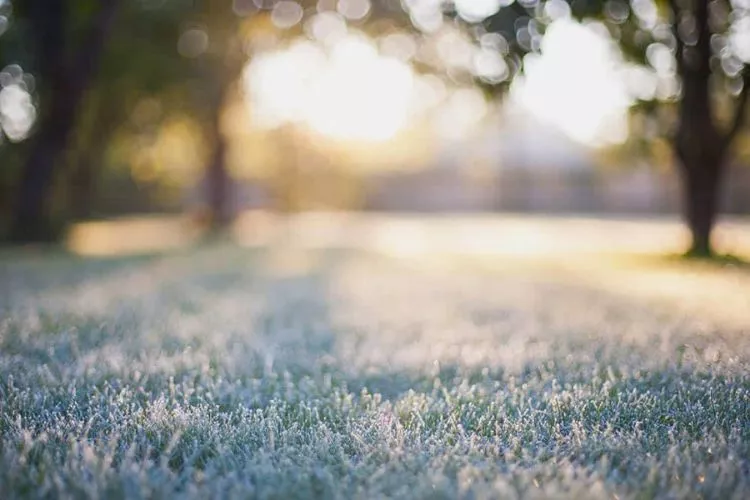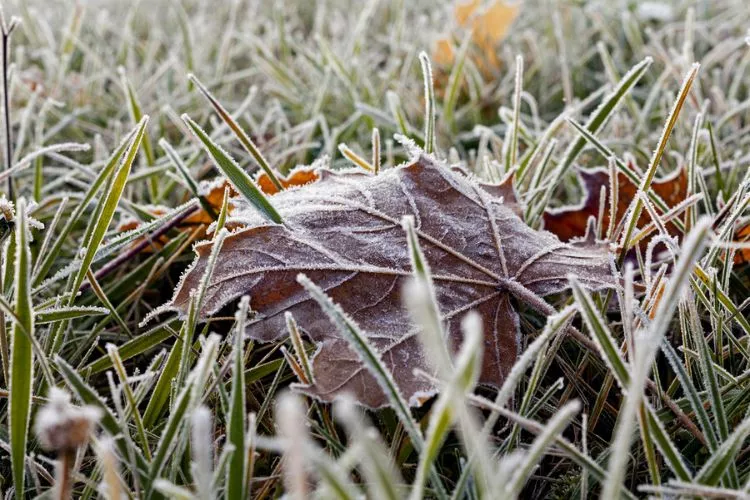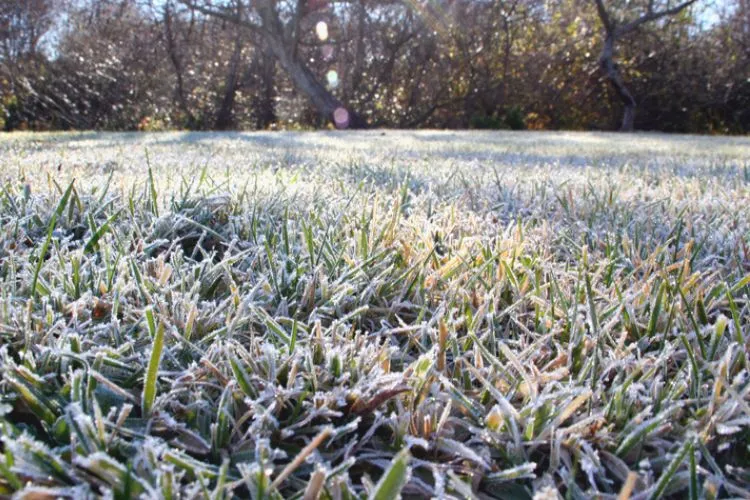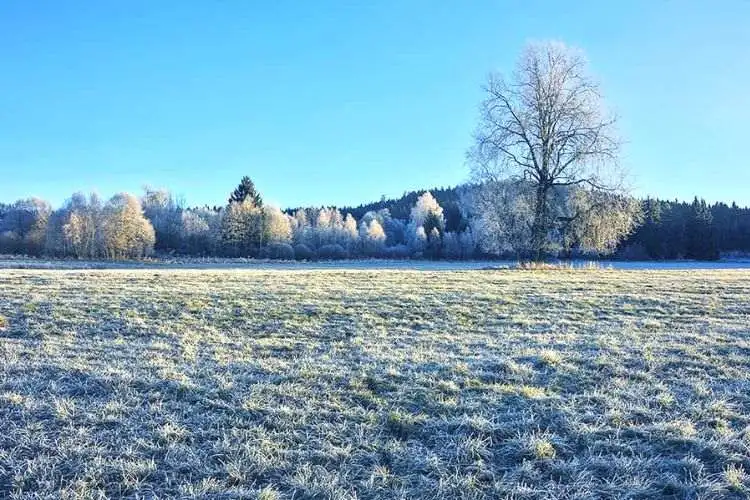Maintaining a healthy lawn requires a little bit of knowledge of how various weather conditions can affect grass growth.
But, will frost damage freshly cut grass?
Well, yes frost can be a major concern, especially for freshly cut grass. It can cause quite a damage to the lawn as well.
In this article, we’ll explore how frost affects freshly cut grass and whether or not it’s a serious concern.

We’ll also go through some preventative measures if frost becomes a problem for your freshly cut grass. Sound good? Let’s go!
Table of Contents
Will frost damage freshly cut grass? (My Real Talk)
Frost can be quite damaging to freshly cut grass, but the extent of the damage can vary depending on various factors. In some cases, frost may not cause any harm at all.
Freshly cut grass is especially vulnerable to frost because it is more exposed to the elements. When the temperature drops below freezing, frost can form on the surface of the grass blades. This frost can affect the moisture content of the grass, which impacts its ability to grow and thrive.
When the grass is exposed to frost, the water inside the blades becomes frozen and expands. This causes the cell walls to rupture. The damage can impact the growth of the grass and lead to brown patches or dead spots on the lawn.
The impact of frost on the growth of freshly cut grass can vary depending on the duration and intensity of the frost. In some cases, the grass may recover on its own, while in other cases, it may require some elbow grease to revive it.
Preventing Frost Damage to Freshly Cut Grass
In cases where frost can cause problems to freshly cut grass, you can use several best practices and techniques to minimize its damage and protect your lawn during colder months.
One of the best ways to do so is by simply avoiding mowing it too short before the first signs of cold weather appear. That’s easier said than done, but predicting impending cold snaps is vital to grass health.
Shorter grass is more susceptible to frost damage, as it has less insulation to protect the roots from the cold.
Another way to protect your lawn is to water it less frequently in the weeks leading to colder weather. Easing up on the water will allow the grass to develop a deeper, stronger root system, which can help to protect it against frost.

You can also use protective coverings such as burlap, straw, or blankets over your grass that act as a shield or barrier. These coverings help by trapping heat and moisture around the grass, providing extra insulation and protection.
Lastly, it’s also important to consider the timing of your lawn care activities. If possible, always avoid mowing or trimming just before a frost.
As mentioned, freshly cut grass is more vulnerable to damage during this time. Instead, consider mowing your lawn during the warmer parts of the day when frost is less likely to occur. The mornings are generally the coldest periods.
Steps to Take if Frost Damage Occurs
If your freshly cut grass has already been damaged by frost, it’s important to repair the damage and prevent it from happening again. Here are some simple steps you can follow if frost damage occurs:
Identify the Signs of Frost Damage on Freshly Cut Grass
The signs of frost damage on freshly cut grass can vary depending on the severity of the damage. You may sometimes see the grass turn brown or even yellow. It may also appear wilted or limp. If left unattended, the grass may die or have brown spots.
Measures to Take to Repair Frost-Damaged Grass
If your freshly cut grass has been damaged by frost, several measures can be taken to repair the damage. One of the best ways to help the grass recover is to allow it some time to regrow on its own. This may mean avoiding mowing the grass for a few weeks and giving it extra time to recover.

You’ll be surprised how much growth a few sunny days can produce. Another method worth trying is fertilizing the grass with a high-nitrogen fertilizer to help it recover more quickly. Be sure to water the grass regularly to help it grow and stay healthy.
How to prevent frost damage to freshly cut grass from occurring again?
To prevent frost damage from occurring again, it’s important to take the necessary precautions before the problem begins. This may include avoiding mowing your lawn too short before colder weather sets in, watering your lawn less frequently, and using protective coverings to shield your lawn from the cold.

It’s also a good idea to monitor the weather, but when a cold snap is headed your way, the risks of a damaged lawn become much greater. Taking these seemingly small but helpful steps can help prevent frost damage and ensure that your freshly cut grass stays healthy and vibrant throughout the colder months.
Is it better to leave your lawn long or short for winter?
When caring for your lawn during the winter months, many homeowners wonder whether it’s better to let their lawn grow as it wishes or trim it back beforehand. The answer depends on several factors, including the type of grass, the climate, and your preferences.
Generally, it’s better to leave your lawn a bit longer during winter. This provides more insulation for the roots and can help protect them from frost and freezing temperatures.

However, you probably don’t want to leave your lawn to get too long, as this can create a breeding ground for a range of pests and diseases. A good rule of thumb is to keep your grass at the height of around 2-3 inches during winter.
If you’re unsure of the best height for your grass, consult with a lawn care professional or your local gardening center. They can help you determine the best height for your grass and provide tips on caring for it during the colder months.
Frequently Asked Questions (FAQs)
What temperature is too cold to mow grass?
It’s generally recommended that you avoid mowing your lawn when the temperature is below 40°F (4°C). Mowing a lawn in colder temperatures can cause the grass to become stressed, impacting its ability to grow and thrive.
How long after frost can I mow?
You should always wait until the frost has melted before mowing your lawn again. Mowing the grass while it’s still frozen can cause damage to the grass blades, which can impact the growth of the grass and often cause irreparable damage.
What happens if you cut your grass too short before winter?
Cutting your grass too short before winter can lead to damage and stress on the grass. Shorter grass leaves it vulnerable to damage caused by frost and freezing temperatures, which in turn destroys the roots and impacts the overall growth of the grass.
Is it OK to cut grass in November?
Yes, it’s generally OK to cut grass in November (depending on which hemisphere you live), as long as the weather conditions are favorable. It’s important to avoid mowing the grass when the ground is wet or frosty, as this can cause damage to the grass blades and impact the growth of the grass.
What month should you stop mowing the lawn?
The month you should stop mowing the lawn depends on the climate and weather conditions in your area. In general, it’s a good idea to stop mowing your lawn once the temperature consistently drops below 50°F (10°C). This will help protect your lawn from the effects of colder weather and prepare it for the upcoming winter months.
Conclusion:
ts freshly cut grass is essential to maintaining a healthy lawn. By taking the necessary precautions, you can prevent frost damage and ensure your grass stays healthy, happy, and vibrant throughout the colder months.
From best practices for minimizing frost damage to techniques for protecting freshly cut grass, this guide has covered everything you need to know and more.
We hope that this guide has been helpful. You can read about similar topics here on our website.


